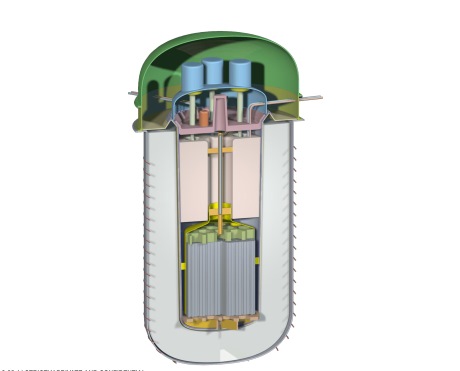Canadian company Terrestrial Energy is to collaborate with the USA's Oak Ridge National Laboratory (ORNL) to develop its molten salt reactor to the engineering blueprint stage.
 |
| Cross-section of IMSR (Image: Terrestrial Energy) |
Molten salt reactors (MSRs) use fuel dissolved in a molten fluoride or chloride salt. As an MSR fuel salt is a liquid, it functions as both the fuel (producing the heat) and the coolant (transporting the heat away and ultimately to the power plant). This means that such a reactor could not suffer from a loss of coolant leading to a meltdown. The basic technology is not new - it was first demonstrated at ORNL in the 1960s, where a 7.4 MWt test reactor, the Molten Salt Reactor Experiment (MSRE), operated from 1965 to 1969.
Terrestrial's Integral Molten Salt Reactor (IMSR) builds on that early work and also on ORNL's later Denatured Molten Salt Reactor (DMSR) design. Indeed, several former ORNL scientists sit on Terrestrial Energy's advisory board, and Terrestrial Energy CEO Simon Irish explained to World Nuclear News that it makes "absolute sense" to work with ORNL which already has the expertise and experience with the design from which IMSR evolved.
The collaboration with ORNL is expected to enable the IMSR to complete the conceptual design stage - where all design parameters are fully specified to start preparing engineering blueprints - in late 2016.
Terrestrial Energy's standout feature over other MSR projects active today, Irish said, is that it already has a reactor design specified to a recognised industrial level, putting the company in a strong market position.
The small modular design integrates primary reactor components in a sealed and replaceable core vessel that has a projected life of seven years. The IMSR will operate at approximately 700°C, which can support many industrial process heat applications, and Terrestrial intends to offer models ranging from 80 to 600 MWt, which it says would be ideally suited for remote communities and industrial operations.
MSRs are today being studied in various programs as a prospective way of using thorium-based fuel. However, unlike those programs, Terrestrial Energy is not considering such a route for their IMSR. In addition to licensing complexities - thorium is not currently licensed as a nuclear fuel - the company says that the exceptional efficiency and reduced waste profile its design offers means that there would be little or no benefit in using a thorium cycle in its reactor.
The collaboration with ORNL follows the December 2014 signature of a letter of intent by Terrestrial Energy and the Canadian Nuclear Laboratories (CNL), covering the provision of CNL's R&D, analysis and testing services, to the project.
Researched and written
by World Nuclear News




_18570.jpg)
_16159.jpg)
_18938.jpg)
_33584.jpg)





